|
 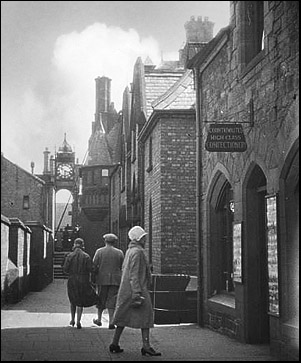 oregate
and Eastgate Streets lay on the line of Watling Street, the
Saxon name for the great Roman road which commenced at Dover, passed through
London and crossed the country to enter the fortress of Deva at the now-vanished
South Gate and leave by the Eastgate, the Porta Principalis Sinistra,
on its way to Manchester and York. oregate
and Eastgate Streets lay on the line of Watling Street, the
Saxon name for the great Roman road which commenced at Dover, passed through
London and crossed the country to enter the fortress of Deva at the now-vanished
South Gate and leave by the Eastgate, the Porta Principalis Sinistra,
on its way to Manchester and York.
(Of particular interest to students of Chester is a chapter in Thomas Codrington's
1903 Roman Roads in Britain dealing with ancient Watling Street,
which you may read here)
Right: an evocative view of the City Wall and Eastgate Clock in the 1920s
Eastgate
Street
and
its
continuation
beyond
the Cross, Watergate
Street,
lie
approximately
on
the
line
of
the
main
thoroughfare
of
Roman
Deva,
the Via
Principalis (Chester,
incidentally,
is
the
only
city
in
Britain
where
the
main
streets
are
signposted
in
both
English
and
Latin).
From
where
we
stand,
the
street
extends
220
yards
to
the
Cross
and
the
square
tower
of St. Peter's
Chuch,
the
site
of
the
southern
side
of
the
great Principia,
or
Roman
headquarters
building
and
on
again
the
same
distance-
the
tall
spire
of Holy
Trinity
Church in
Watergate
Street
marks
the
site
of
the
vanished
West
Gate,
or Porta
Principalis
Dextra.
This
shows
at
a
glance
the
extent
of
the
fortress
across
its
narrower
side-
about
440
Could
the
Saxon
founders
of
Holy
Trinity
have
utilised
a
ruined
Roman
gatehouse
adjoining
the
West
Gate
of
the
fortress?
A
very
similar
situation
existed
in
what
is
now
the
middle
of
the
busy
junction
of
Bridge
Street
and Grosvenor
Street,
where
for
centuries
there
stood
a
church
dedicated
to
St. Bridget,
which
was
founded
around
the
year
797
by
King
Offa
on
the
site
of
the
vanished
Roman
South
Gate, or Porta
Praetoria.
Some
mighty
column
bases
from
the
vanished Principia were
discovered
when
the
old Shoemaker's
Row in
Northgate
Street
was
rebuilt
and
have
been
preserved.
You
can
inspect
them
(well
worth
the
effort)-
albeit
through
an
inappropriate
mass
of
merchandise,
in
the
basement
of
what
was
until
recently
a
clothes
shop.
From the Cross, the ancient meeting place of the principal streets of Chester,
a right turn will take you back to our starting place, the Northgate,
a left takes you down Bridge Street to the River Dee and the Bridgegate while continuing strait on into Watergate Street will eventually bring us
to the Watergate. On either side, you
can see the openings of the remarkable covered galleries known as The Rows,
an architectural feature unique to Chester. There are numerous theories as to their 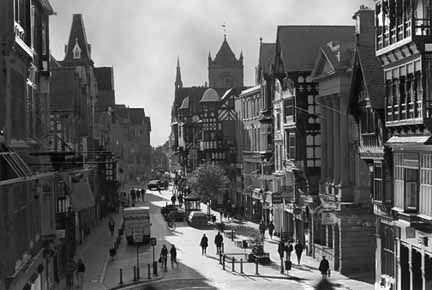 origins, for example, that they
evolved from the structures that came to be erected, one row above another,
on the sloping piles of rubble that lined the main streets in the centuries
following the departure of the Legions and the destruction of the buildings
within their great fortress. Go here to read Joseph Hemingway's lengthy description of the Rows, written 170 years ago, in 1836 but still entirely recognisable today. origins, for example, that they
evolved from the structures that came to be erected, one row above another,
on the sloping piles of rubble that lined the main streets in the centuries
following the departure of the Legions and the destruction of the buildings
within their great fortress. Go here to read Joseph Hemingway's lengthy description of the Rows, written 170 years ago, in 1836 but still entirely recognisable today.
Left: Eastgate Street. When the Prince of Wales, the future Edward VII, visited Chester in 1869 to open the Town Hall, he exclaimed as he seated himself in the Mayor's open carriage, and looked at this view towards the High Cross from the Grosvenor Hotel, " What a glorious picture! "What a beautiful skyline!"
"Chester is a town of balconies. The first impression I received
of it was a town whose inhabitants spend a great portion of their lives
leaning over old oak galleries, smoking and chatting and watching life go
by below them in the streets.
The Rows are simply long, covered arcades formed by running a highway through
the first stories of a street of old buildings. You mount from the roadway
to the Rows on frequent flights of stone steps and find yourself in the
strangest shopping streets in England. Here are the best shops hidden away
in the darkness of these ancient arcades, and it is possible to shop dry-shod
in the worst weather.
There is a peculiar charm about these Rows. They are not typically medieval,
because there is no record of any other street of this kind in the Middle
Ages, yet they impart a singular impression of medievalism: through the
oak beams which support the galleries you see black-and-white half-timbered
houses on the opposite side of the street, with another Row cut through
their first floors, on whose balconies people are leaning and talking and
regarding the flow of life.
The main streets of Chester give you the impression that a huge galleon
has come to anchor there with easy, leisurely passengers leaning on the
deck rails"
H. V. Morton: In Search of England 1924
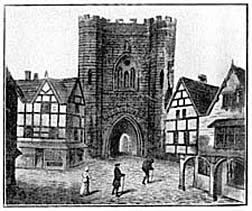 You
can
read
more
of
Mr Morton's
impressions
of
Chester here. You
can
read
more
of
Mr Morton's
impressions
of
Chester here.
The
Eastgate
The
present
Eastgate
was
designed by one Mr Hayden and erected
in
1769 at the expense of Richard, Lord Grosvenor. It comprises a
plain
stone
archway
with
small
posterns
on
either
side
for
pedestrian
access.
On
the
outside
of
the
gate
are
the
arms
of
the
Grosvenors
and
the
inscription:
"ERECTED
AT
THE
EXPENCE
OF
RICHARD
LORD
GROSVENOR
A:D:
MDCCLXIX"
On
the
west
side
are
displayed
the
city
arms
and,
"THIS
GATE
BEGUN
A.D.
MDCCLXVIII
JOHN
KELSALL
ESQr.
MAYOR.
FINISHED
A.D.
MDCCLXIX
CHA.
BOSWELL
ESQr.
MAYOR"
It
replaced
a
great
medieval
structure
formerly
occupying
the
site, "A
goodly
great
gate,
of
an
antient
fair
building,
with
a
tower
upon
it,
containing
many
fair
rooms
within".
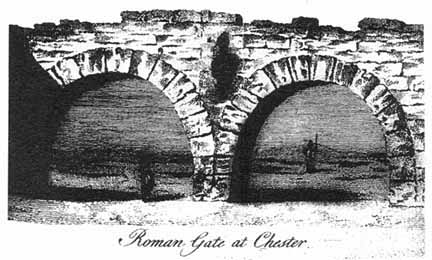 This
old
Eastgate
was
a
massive
affair of high quality masonry of a cream-coloured sandstone,
which must have contrasted strikingly with the red stone which was the norm in the city. It comprised
a
single
pointed
arch
supporting
a
great
high
square
battlement
of
stone
with
octagonal
corner
turrets,
arrowslits
and
crenellations.
There were small flanking towers. The
tower
above
it
was
known
as
the Harre (Harry) Tower. This
old
Eastgate
was
a
massive
affair of high quality masonry of a cream-coloured sandstone,
which must have contrasted strikingly with the red stone which was the norm in the city. It comprised
a
single
pointed
arch
supporting
a
great
high
square
battlement
of
stone
with
octagonal
corner
turrets,
arrowslits
and
crenellations.
There were small flanking towers. The
tower
above
it
was
known
as
the Harre (Harry) Tower.
In 1586, the Harre Tower was let to the Joiner's Company at a yearly rental of 6s. 8d.
We are unsure as to when exactly this great structure was erected but it does bear striking similarities to Caernarfon Castle and it is recorded that, in 1270, Henry III acquired land at the East Gate from one Agnes de Novo Castello (New Castle) which was confirmed in a writ of 1307. So a construction date sometime in the early 14th century seems likely.
This
medieval
gate
in
turn
replaced
the
original
Roman
entrance,
while
incorporating
much
of
that
structure
within
it.
Drawings
exist
recording
the
demolition
of
the
medieval
gate,
clearly
showing
the
twin
barrel-vaulted
arches
of
the
Roman
entrance,
14
feet
high
and
20
feet
apart,
complete
with
guard
houses
on
each
side.
Mounted
between
the
arches
was
a
sculpted
image
of
a
centurion,
or
perhaps
of
Mars,
the
Roman
god
of
war,
arrayed
in
armour
and
holding
a
shield
in
one
hand
and
a
spear
in
the
other.
Whoever
it
actually
represented,
this
image
must
have
been
a
welcome
sight
to
generations
of
tired
Roman
infantrymen
approaching
the
end
of
a
long
march.
Distinguished
18th
century
travel
writer
and
naturalist Thomas
Pennant,
alluding
to
the
old
gate,
wrote "I
remember
the
demolition
of
the
ancient
structure,
and
on
taking
down
the
more
modern
case
of
Norman
masonry
the
Roman
appeared,
full
in
view.
It
consisted
of
two
arches,
formed
of
vast
stones,
fronting
the
Eastgate
Street
and
Forest
Street -
the
pillar
between
them
dividing
the
street
exactly
in
two".
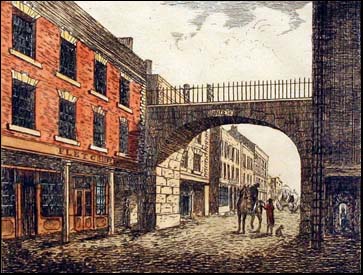 (The name of Forest Street, incidentally- now Foregate Street- had, as is commonly claimed, nothing to do with it being the road to the forests that once thrived beyond the city but was a corruption of 'Fore-East Street'- the street before the Eastgate.) (The name of Forest Street, incidentally- now Foregate Street- had, as is commonly claimed, nothing to do with it being the road to the forests that once thrived beyond the city but was a corruption of 'Fore-East Street'- the street before the Eastgate.)
In
1910,
Chester
historian Frank
Simpson commented "What
a
pity
it
was
ever
to
have
removed
the
ancient
Eastgate
at
all.
What
a
beautiful
relic
of
Norman
times
would
have
now
remained
if
the
road
had
been
diverted
on
either
side
of
it!"
Right: the Eastgate as it appeared in 1820, viewed from outside the City Walls.
Writing in 1858, the excellent Thomas Hughes expressed it rather more strongly: "Handsome and commodious as is the present Eastgate- on every score but that of convenience, it is immeasurably inferior to its predecessor. Could we but look upon the structure as it existed only a hundred years ago, with its beautiful Gothic archway, flanked by two massive octagonal towers, four stories in height, supporting the gate itself and the rooms above- could we but resuscitate the time-worn battlements of that "ancient of days", we should wonder at and pity the spurious taste that decreed its fall. "Oh but", we may be told, "the present gate is a public improvement". A plague upon such improvements, say we! We would vastly have preferred, and so would every lover of the antique, whether citizen or stranger, to have retained the old gate in its integrity, altered, had need been, to meet the growing wants of the times, rather than have thus consigned it to the ruthless hands of the destroyer. Oh! Ye spirits of the valiant dead- you who lost your lives defending this gate against Cromwell, why did ye not rise up from your graves and arrest the mad course of that "age of improvement?"
Tragically,
that
which
had
miraculously
survived
for
around
sixteen
hundred
years
was
thoughtlessly
done
away
with
in
a
matter
of
days.
All
that
now
survives
is
a
section
of
wall
which
probably
belonged
to
one
of
the
guard
chambers
preserved
in
the
cellar
of
no. 48
Eastgate
Street.
The 'Honorable
Incorporation'
As
you
look
at
the
Eastgate
from
within
the
wall,
on
the
left-hand
side,
immediately
next
to
the
gate
is
a
narrow
passageway.
At
the
end
of
this,
in
what
is
now
the
premises
of
a
bank,
formerly
existed
a
public
house
called
The King's
Arms
Kitchen, also known as Mother Hall's.
You
may
just
see
its
sign
on
the
left
of
the
Eastgate
in
the
photograph
below,
which
was
taken
about
1900.
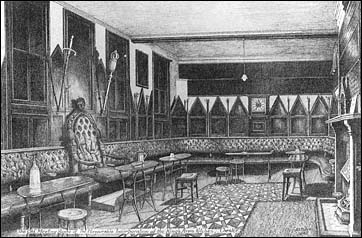 In
the
18th
and
19th
centuries,
it
housed
a
society
going
by
the
splendid
name
of The
Honorable
Incorporation
of
the
King's
Arm's
Kitchen.
This came about as the result of an order by King Charles II that the custom of electing the mayor and his officers was to end. Sir Thomas Grosvenor was appointed as mayor, thus spawning an oligarchy between Eaton Hall (the Grosvenor residence) and Chester Corporation that would last until the Election Reform Act of 1832. The city's people were, unsurprisingy, increasingly unhappy with this imposition of an unelected mayor and Corporation, and one evening around the year 1770, a group of tradesmen met in a room in this pub and decided to form a City Assembly of their own, which
was
organised
(a wonderful idea) as
a
complete shadow assembly, a satirical
imitation
of
the
Corporation,
with
its
own
elected
mayor,
recorder,
town
clerk,
sheriffs, aldermen and common councilmen. They even had a replica of the mayor's sword and mace made for them. Their meeting room was fitted with beautiful, diamond shaped oak panels (said to have been fashioned from old pew doors from St John’s Church), plush seating and a grand mayoral throne. On either side of the fireplace were cupboards for the storing of 'churchwardens'- long clay pipes which each member marked with his own monogram. An oil painting of the Royal Arms- the Lion & the Unicorn- was presented by Mr Clowes, a heraldic painter and inscribed “This picture is the property of the Incorporated Society of the King’s Arms Kitchen”. In
the
18th
and
19th
centuries,
it
housed
a
society
going
by
the
splendid
name
of The
Honorable
Incorporation
of
the
King's
Arm's
Kitchen.
This came about as the result of an order by King Charles II that the custom of electing the mayor and his officers was to end. Sir Thomas Grosvenor was appointed as mayor, thus spawning an oligarchy between Eaton Hall (the Grosvenor residence) and Chester Corporation that would last until the Election Reform Act of 1832. The city's people were, unsurprisingy, increasingly unhappy with this imposition of an unelected mayor and Corporation, and one evening around the year 1770, a group of tradesmen met in a room in this pub and decided to form a City Assembly of their own, which
was
organised
(a wonderful idea) as
a
complete shadow assembly, a satirical
imitation
of
the
Corporation,
with
its
own
elected
mayor,
recorder,
town
clerk,
sheriffs, aldermen and common councilmen. They even had a replica of the mayor's sword and mace made for them. Their meeting room was fitted with beautiful, diamond shaped oak panels (said to have been fashioned from old pew doors from St John’s Church), plush seating and a grand mayoral throne. On either side of the fireplace were cupboards for the storing of 'churchwardens'- long clay pipes which each member marked with his own monogram. An oil painting of the Royal Arms- the Lion & the Unicorn- was presented by Mr Clowes, a heraldic painter and inscribed “This picture is the property of the Incorporated Society of the King’s Arms Kitchen”.
In the course of time, the serious, satirical point of the King's Arms Kitchen was largely lost and it degenerated into a drinking and gambling club. The regulars, however, did not forget the old rules and regulations, such as that which declared that if a stranger sat in the mayor's chair, it was his duty to buy drinks for all present. During the Second World War, many an American GI was invited to sit in the mayor's chair!
The
fittings
of
the
room
(illustrated above) where
this
worthy
institution
met,
complete
with
wood
panelling
upon
which
was
inscribed
the
succession
of
member's
names,
was
preserved
when
the
pub
closed
in
1978,
and
was
transferred
to
the Grosvenor
Museum,
where
they
were
imaginitively
incorporated
into
the
decor
of
the
museum's
teashop,
and
may
still
be
seen
there
today.
Go here to
find
out
much more,
and
read
the
fascinating
reminiscences
of
an
anonymous
19th
century
'frequenter'...
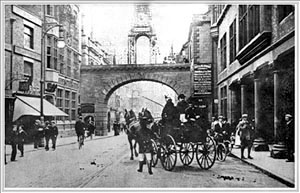 On
the
right
of
the
Eastgate
in
this
old
photograph
you
can
see
Huxley's
Vaults,
a
public
house
and
wine
merchant
established
here
in
1783
and
surviving
until
the
1960s.
For unknown reasons (possibly fortunately) Huxley's was also fondly known by its habituees as Dirty Dick's. It was later owned by the Northgate Brewery and only had a six-day licence, being closed on Sundays. The brewery had converted the upper parts of the pub for living accomodation before the war and this then bore the distinguished address of 'Number 11, City Walls'. After the sad demise of the pub, the Leeds Building Society, and later the Halifax, took over the premises and later it housed a moble phone shop but today it is occupied by Milton's jewellers and pawnbrokers. There is a mystery about the Grade II listed building- if you stand outside the Grosvenor Hotel and look up you can see a brass porthole in the side wall. Legend had it that an old sea captain had it put in many years earlier to remind him of his days at sea... On
the
right
of
the
Eastgate
in
this
old
photograph
you
can
see
Huxley's
Vaults,
a
public
house
and
wine
merchant
established
here
in
1783
and
surviving
until
the
1960s.
For unknown reasons (possibly fortunately) Huxley's was also fondly known by its habituees as Dirty Dick's. It was later owned by the Northgate Brewery and only had a six-day licence, being closed on Sundays. The brewery had converted the upper parts of the pub for living accomodation before the war and this then bore the distinguished address of 'Number 11, City Walls'. After the sad demise of the pub, the Leeds Building Society, and later the Halifax, took over the premises and later it housed a moble phone shop but today it is occupied by Milton's jewellers and pawnbrokers. There is a mystery about the Grade II listed building- if you stand outside the Grosvenor Hotel and look up you can see a brass porthole in the side wall. Legend had it that an old sea captain had it put in many years earlier to remind him of his days at sea...
(For much more about the
vanished watering holes of Chester go here.)
The
coach
is
pulling
away
from
the Chester Grosvenor
Hotel,
the
site
of
which
was
originally
occupied
by The Golden Talbot, advertised in the long-defunct Adam's Weekly Courant of 17th September 1751 as "that ancient and well-accustomed inn which is now fitted up in the neatest manner and held by Thomas Hickman (late agent to the Hon. Colonel Lee deceas'd) where all gentlemen, ladies and others who shall be pleased to make use of the said house may depend on the best accomodations and most civil usage".
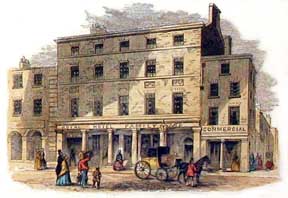 The old Talbot was demolished and on its site rose The Royal
Hotel (illustrated right)
which
was
built
in
1784
by
one
John
Crewe,
who,
together
with
a
Mr Barnston
stood
for
Parliament
as
Whigs
against
Mr Thomas
Grosvenor
and
Mr
Richard
Wilbraham
Bootle
who,
as
Tories,
supported
William
Pitt.
The
two
seats
had
been
Grosvenor
family
'perks'
for
decades,
and
the
city
council
were
hand-in-glove
with
them. The old Talbot was demolished and on its site rose The Royal
Hotel (illustrated right)
which
was
built
in
1784
by
one
John
Crewe,
who,
together
with
a
Mr Barnston
stood
for
Parliament
as
Whigs
against
Mr Thomas
Grosvenor
and
Mr
Richard
Wilbraham
Bootle
who,
as
Tories,
supported
William
Pitt.
The
two
seats
had
been
Grosvenor
family
'perks'
for
decades,
and
the
city
council
were
hand-in-glove
with
them.
After
ten
days
of
campaigning,
the
parties
were
neck-and-neck,
until
money
won
the
day-
Mr
Crewe,
described
as
being
of
'only
moderate
fortune,'
spent
£10,000
on
bribes,
but
the
Grosvenors
spent
£20,000
and
the
Tories
were
in.
(However,
eight
years
later,
the Chester
Directory for
1792
shows
John
Crewe
and
Sir
Robert
Salisbury
Cotton
as
representatives
for
the
county,
while
Thomas
Grosvenor
Esq.
and
the
Right
Hon.
Lord
Belgrave
as
members
for
the
city)
The
antagonism
between
the
Grosvenors
and
city
fathers
on
one
hand
and
their
opponents
on
the
other
went
on
for
a
further
30
years,
but,
despite
rulings
against
them
in
the
House
of
Lords,
the
Tory
stranglehold
over
the
city's
affairs
continued
until
the
reform
act
of
1832.
 The Royal
Hotel was
the
opposition's
social
centre,
with
news
and
coffee
rooms
and
an
elegant
assembly
room
for
balls
and
concerts.
Earl
Grosvenor,
however,
had
the
last
laugh.
He
bought
the
building
and
in
1863,
had
it
totally
demolished,
and
replaced
by
the
much
larger
building
we
see
today-
and
named
it
after
his
family. The Royal
Hotel was
the
opposition's
social
centre,
with
news
and
coffee
rooms
and
an
elegant
assembly
room
for
balls
and
concerts.
Earl
Grosvenor,
however,
had
the
last
laugh.
He
bought
the
building
and
in
1863,
had
it
totally
demolished,
and
replaced
by
the
much
larger
building
we
see
today-
and
named
it
after
his
family.
A
century
later,
the
Grosvenor
Hotel
was
considered
a
cosy
and
unpretentious,
if
rather
dowdy
place,
but
it
contained
the
city's
only
large
ballroom
apart
from
that
in
the
Town
Hall,
so
perforce
all
the
balls
(Hunt,
Farmer's,
Conservative and League
of
Pity amongst
them)
were
held
there.
With
the
increasing
prosperity
of
the
city,
the
hotel
underwent
a
programme
of
upgrading
and
refurbishment,
adding
many
modern
conveniences
but
losing
much
of
its
old-world
charm.
Author, broadcaster and all-round character Gyles Brandreth, who served as Chester's
Member of Parliament from 1991-97, referred to the Grosvenor in his wonderfully readable volume of diaries, Breaking the Code thus, "owned by the Duke of Westminster who, I imagine, is about the only person who can actually afford to stay there: it's very lush and very pricey".
Far humbler perhaps, but no less interesting, is a business premises situated just across the road from the Grosvenor Hotel. Following a sign to the city walls immediately next to the Eastgate leads the visitor to a flight of steps, tucked beneath which is the smallest shop in Chester- possibly in the entire country. Formerly the premises of a wool trader, around the year 1895 it became a gentlemen's hairdressers (three customers and the place was packed!)- and stayed that way for 108 years, until November 2003 when its last owner, long-serving traditional barber Bernie Philips retired. A busy sandwich bar now trades from there. Our photograph shows the still-unaltered rear of the premises.
So, having
re-mounted these steps to the city walls and lingered
awhile
to
watch
the
bustling
crowds
beneath,
we
shall
now
press
on
towards
the Newgate...
Curiosities from Chester's History no. 11
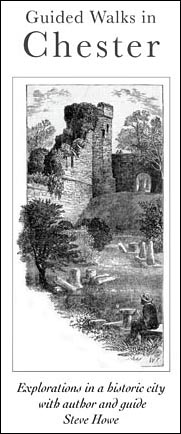 1509 Henry VII died, his second son ascended the throne
as Henry VIII (1491-1547) and married Catherine of Aragon, the widow of his elder brother Arthur. Arthur was the eldest son of Henry and Elizabeth of York. He was born on 20 September 1486, barely a year after the pivotal Battle of Bosworth Field, and died on 2 April 1502. Arthur was named after the mythical King Arthur- Henry VII was Welsh and the legend was popular in medieval England. He was titled Prince of Wales when he was 3 years old. Negotiations for his marriage to Katharine of Aragon, daughter of the famous Ferdinand and Isabella, began in 1488. The terms were settled in 1500 and the couple were married in London on 14 November 1501. They journeyed to Ludlow Castle, the traditional seat of the Prince of Wales, and established a small court. However, Arthur died suddenly on 2 April 1502, possibly of tuberculosis. William
ap John was fined three-halfpence for being a "peeping Tom" 1509 Henry VII died, his second son ascended the throne
as Henry VIII (1491-1547) and married Catherine of Aragon, the widow of his elder brother Arthur. Arthur was the eldest son of Henry and Elizabeth of York. He was born on 20 September 1486, barely a year after the pivotal Battle of Bosworth Field, and died on 2 April 1502. Arthur was named after the mythical King Arthur- Henry VII was Welsh and the legend was popular in medieval England. He was titled Prince of Wales when he was 3 years old. Negotiations for his marriage to Katharine of Aragon, daughter of the famous Ferdinand and Isabella, began in 1488. The terms were settled in 1500 and the couple were married in London on 14 November 1501. They journeyed to Ludlow Castle, the traditional seat of the Prince of Wales, and established a small court. However, Arthur died suddenly on 2 April 1502, possibly of tuberculosis. William
ap John was fined three-halfpence for being a "peeping Tom"
- 1510 An order is made that "none shall attend priest's
offerings, first mass, gospel ales or Welsh weddings, within this city,
under a penalty of ten shillings".
- 1515 A fight took place "betwixte the citizens of Chester
and divers Waylshe men at Saint Warburghe Lane ende but lytill hurt done,
for the Waylesmen fledde".
- 1517 Great visitation of Bubonic Plague; grass grew a
foot high at the High Cross and other streets in the city. Many, it was
said, died "whilst opening their windows." A silence descended upon the
city, relieved only by the cry of the watchmen calling "bring out your
dead" as they went their rounds with the Dead Carts. Before the plague
bore down upon the city, many citzens claimed they witnessed a fiery halo
of light in the heavens above.
- 1519 Hernán Cortéz enters Tenochtitlan,
capital of Mexico, and is received by Montezuma II, the Aztec ruler. Coffee
comes to Europe for the first time.
- 1523 Roger Ledsham, keeper of the Great Gate of the Abbey of St.Werburgh
was drowned in the 'horse-pole' (a pond formerly situated in present-day
Abbey Square)
- 1524 Turkeys from South America first eaten
at the English court. Thomas Highfield becomes twenty fifth
Abbot of St. Werburgh's (-1527)
- 1526 The Abbey cloisters were rebuilt.
- 1527 Thomas Marshall becomes twenty sixth Abbot of St. Werburgh's until
1529, when he is succeeded by the penultimate abbot, John Birchenshawe (-1538)
- 1530 King Henry VIII recognised as Supreme Head of the Church of England.
- 1531 The 'great comet' (later to be known as Halley's Comet) arouses
a wave of superstitious fears throughout Europe
- 1533 Henry secretly marries Anne Boleyn (1501-1536) and is excommunicated by the
Pope. The Mayor of Chester, Henry Gee, ordered that "no manner person
or persons go abroade in this citie mumming in any place within the said
citie, their fayses being coveryd or disgysed (because) many dysordered
persons have used themselves rayther all the day after idellie in vyse
and wantoness then given themselves to holy contemplation and prayre the
same sacryt holye and prynsepaul feast." He also ordered that ale, beer
and wine were not to be sold after 9pm on any day or after Divine Service
on Sundays. The reforming Mayor Gee also had much to say regarding the
activities of Chester's citizens on the Roodee.
- 1535 Sir Thomas Moore, having refused the oath of the king's supremacy,
is tried for treason and executed.
- 1536 Catherine of Aragon died. Queen Anne Boleyn beheaded at the Tower
of London. Henry marries Jane Seymour.
- 1537 Chester's religious houses were suppressed on the
order of the Mayor, Ffoulk Dutton. At the dissolution there were 10 White
Friars, 7 Grey Friars, 5 Black Friars and 14 ladies at St.
Mary's Nunnery. Water was first brought from Boughton to the Bridgegate by lead pipes. Jane Seymour dies in childbirth; her son, the future King Edward VI, was created Earl
of Chester at his birth.
- 1538 Thomas Clarke becomes twenty eigth and final Abbot of St. Werburgh's
(-1540)
|

 oregate
and Eastgate Streets lay on the line of Watling Street, the
Saxon name for the great Roman road which commenced at Dover, passed through
London and crossed the country to enter the fortress of Deva at the now-vanished
South Gate and leave by the Eastgate, the Porta Principalis Sinistra,
on its way to Manchester and York.
oregate
and Eastgate Streets lay on the line of Watling Street, the
Saxon name for the great Roman road which commenced at Dover, passed through
London and crossed the country to enter the fortress of Deva at the now-vanished
South Gate and leave by the Eastgate, the Porta Principalis Sinistra,
on its way to Manchester and York. origins, for example, that they
evolved from the structures that came to be erected, one row above another,
on the sloping piles of rubble that lined the main streets in the centuries
following the departure of the Legions and the destruction of the buildings
within their great fortress. Go
origins, for example, that they
evolved from the structures that came to be erected, one row above another,
on the sloping piles of rubble that lined the main streets in the centuries
following the departure of the Legions and the destruction of the buildings
within their great fortress. Go 
 This
old
Eastgate
was
a
massive
affair of high quality masonry of a cream-coloured sandstone,
which must have contrasted strikingly with the red stone which was the norm in the city. It comprised
a
single
pointed
arch
supporting
a
great
high
square
battlement
of
stone
with
octagonal
corner
turrets,
arrowslits
and
crenellations.
There were small flanking towers. The
tower
above
it
was
known
as
the Harre (Harry) Tower.
This
old
Eastgate
was
a
massive
affair of high quality masonry of a cream-coloured sandstone,
which must have contrasted strikingly with the red stone which was the norm in the city. It comprised
a
single
pointed
arch
supporting
a
great
high
square
battlement
of
stone
with
octagonal
corner
turrets,
arrowslits
and
crenellations.
There were small flanking towers. The
tower
above
it
was
known
as
the Harre (Harry) Tower.  (The name of Forest Street, incidentally- now Foregate Street- had, as is commonly claimed, nothing to do with it being the road to the forests that once thrived beyond the city but was a corruption of 'Fore-East Street'- the street before the Eastgate.)
(The name of Forest Street, incidentally- now Foregate Street- had, as is commonly claimed, nothing to do with it being the road to the forests that once thrived beyond the city but was a corruption of 'Fore-East Street'- the street before the Eastgate.)  In
the
18th
and
19th
centuries,
it
housed
a
society
going
by
the
splendid
name
of The
Honorable
Incorporation
of
the
King's
Arm's
Kitchen.
This came about as the result of an order by King Charles II that the custom of electing the mayor and his officers was to end. Sir Thomas Grosvenor was appointed as mayor, thus spawning an oligarchy between Eaton Hall (the Grosvenor residence) and Chester Corporation that would last until the Election Reform Act of 1832. The city's people were, unsurprisingy, increasingly unhappy with this imposition of an unelected mayor and Corporation, and one evening around the year 1770, a group of tradesmen met in a room in this pub and decided to form a City Assembly of their own, which
was
organised
(a wonderful idea) as
a
complete shadow assembly, a satirical
imitation
of
the
Corporation,
with
its
own
elected
mayor,
recorder,
town
clerk,
sheriffs, aldermen and common councilmen. They even had a replica of the mayor's sword and mace made for them. Their meeting room was fitted with beautiful, diamond shaped oak panels (said to have been fashioned from old pew doors from
In
the
18th
and
19th
centuries,
it
housed
a
society
going
by
the
splendid
name
of The
Honorable
Incorporation
of
the
King's
Arm's
Kitchen.
This came about as the result of an order by King Charles II that the custom of electing the mayor and his officers was to end. Sir Thomas Grosvenor was appointed as mayor, thus spawning an oligarchy between Eaton Hall (the Grosvenor residence) and Chester Corporation that would last until the Election Reform Act of 1832. The city's people were, unsurprisingy, increasingly unhappy with this imposition of an unelected mayor and Corporation, and one evening around the year 1770, a group of tradesmen met in a room in this pub and decided to form a City Assembly of their own, which
was
organised
(a wonderful idea) as
a
complete shadow assembly, a satirical
imitation
of
the
Corporation,
with
its
own
elected
mayor,
recorder,
town
clerk,
sheriffs, aldermen and common councilmen. They even had a replica of the mayor's sword and mace made for them. Their meeting room was fitted with beautiful, diamond shaped oak panels (said to have been fashioned from old pew doors from 
 The old Talbot was demolished and on its site rose The Royal
Hotel (illustrated right)
which
was
built
in
1784
by
one
John
Crewe,
who,
together
with
a
Mr Barnston
stood
for
Parliament
as
Whigs
against
Mr Thomas
Grosvenor
and
Mr
Richard
Wilbraham
Bootle
who,
as
Tories,
supported
William
Pitt.
The
two
seats
had
been
Grosvenor
family
'perks'
for
decades,
and
the
city
council
were
hand-in-glove
with
them.
The old Talbot was demolished and on its site rose The Royal
Hotel (illustrated right)
which
was
built
in
1784
by
one
John
Crewe,
who,
together
with
a
Mr Barnston
stood
for
Parliament
as
Whigs
against
Mr Thomas
Grosvenor
and
Mr
Richard
Wilbraham
Bootle
who,
as
Tories,
supported
William
Pitt.
The
two
seats
had
been
Grosvenor
family
'perks'
for
decades,
and
the
city
council
were
hand-in-glove
with
them. The Royal
Hotel was
the
opposition's
social
centre,
with
news
and
coffee
rooms
and
an
elegant
assembly
room
for
balls
and
concerts.
Earl
Grosvenor,
however,
had
the
last
laugh.
He
bought
the
building
and
in
1863,
had
it
totally
demolished,
and
replaced
by
the
much
larger
building
we
see
today-
and
named
it
after
his
family.
The Royal
Hotel was
the
opposition's
social
centre,
with
news
and
coffee
rooms
and
an
elegant
assembly
room
for
balls
and
concerts.
Earl
Grosvenor,
however,
had
the
last
laugh.
He
bought
the
building
and
in
1863,
had
it
totally
demolished,
and
replaced
by
the
much
larger
building
we
see
today-
and
named
it
after
his
family. 